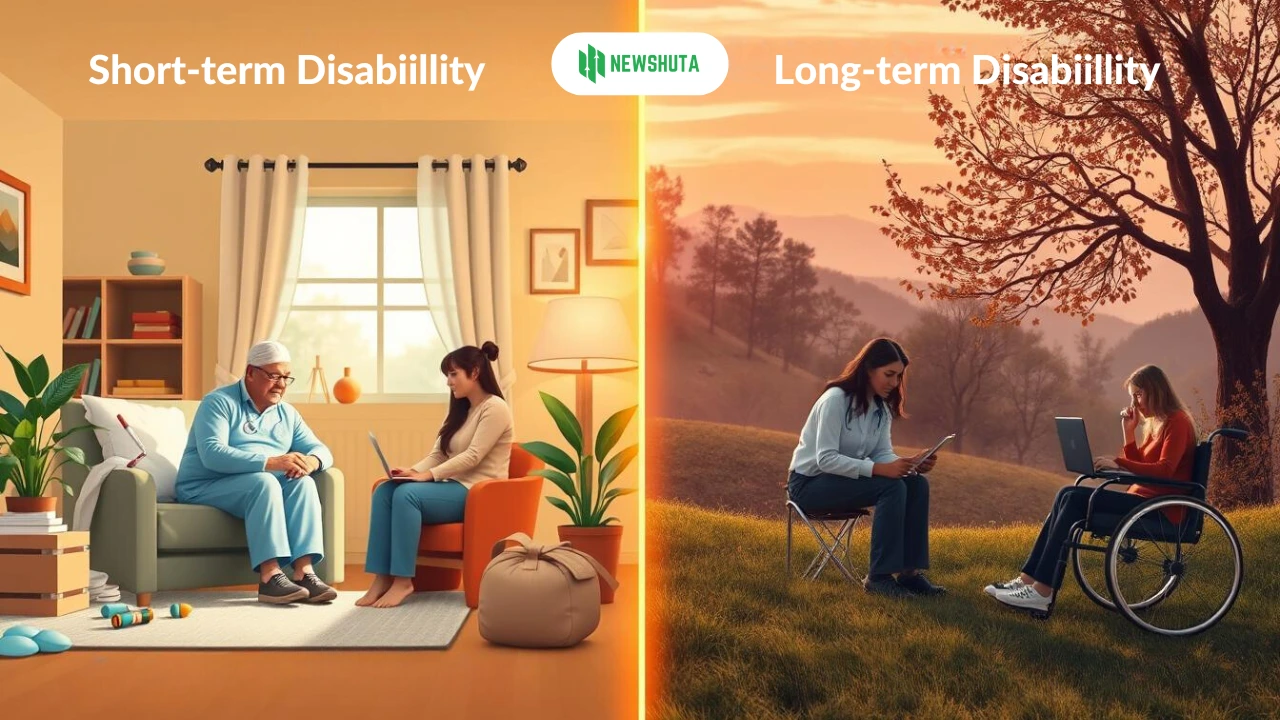Picture yourself as the main breadwinner of the household which will take care of your family. But how would you fare when sickness or injury finally keeps you out of work? This is where disability insurance comes to the rescue, to protect your pocket. It is most important to recognize the difference between short-term and long-term coverage to serve your need.
According to the 2021 Fact Sheet from LIMRA, disability insurance plays an important role. It is particularly useful as it replaces a large portion of one’s wages when sick leave is not an option. More statistics published by Social Security Administration state that 1 in every 4 twenty year old kids w would be disabled before reaching age 67. This makes it clear how important it is to plan for the future ahead and have forethought such as taking the right insurance.
Understanding Disability Insurance Coverage
Disability insurance is one of the most important safeguards that is potential when you are incapable of performance because of any injuries or sickness. They can be classified into two that is short-term and long-term. Short term covers the income support towards the pay for a maximum 12 months period during which the individual is unable to perform his normal field. Long-term ecompasses any kind of work to a period for so many years or till ones retirement age.
Types of Disability Insurance
There are different policies of coverage such as partial vs. total disability which have to be differentiated and their limitations understood as well. When selecting the best policy, considerations such as premiums and pre-existing conditions can also come in handy.
Importance of Disability Protection
Not having disability coverage can be detrimental to the financial stability and security of a person. This is crucial in times when you are not able to work and earn due to a serious accident or health issue. In the absence of this coverage, one could face considerable financial problems due to medical bills or loss of wages..
“Disability insurance is a financial safety net that can provide peace of mind and financial security when you need it most.”
Short-term Disability Insurance
This variant is most vital when the employee has been injured and is therefore unable to work. It offers almost half to three-quarters of the earnings but for some weeks usually two months. Depending on the policy this time ranges from a couple of weeks to one full year.
Coverage Period and Benefits
This benefit is also time-limited, and this restriction varies from a few weeks to up to a year. Some states (like New York, California, etc.) and countries (like Rhoad Island) require employers to provide this just because many employees are receiving it. It is quite useful, as it replaces most of the employee’s income when he is out of work due to accident or illness.
Qualifying Conditions and Elimination Period
Short-term disability is illness coverage provided. To get these benefits usually the employee requires a doctor’s note stating that the claimant is unable to work. This includes things like having an operation, having an accident or a maternity leave. Apart from this, there is also an elimination period. This is the period between the onset of the injury and the point at which the physical damaged begins to attract any forms of benefits. It normally ranges within a period of 7 to 30 days, 14 days being the most common.
“Short-term disability insurance can be a valuable safety net for employees, providing financial support during unexpected medical events that temporarily prevent them from working.”
Long-term Disability Insurance
Short-term disability is illness coverage provided. To get these benefits usually the employee requires a doctor’s note stating that the claimant is unable to work. This includes things like having an operation, having an accident or a maternity leave. Apart from this, there is also an elimination period. This is the period between the onset of the injury and the point at which the physical damaged begins to attract any forms of benefits. It normally ranges within a period of 7 to 30 days, 14 days being the most common.
Coverage Duration and Benefit Amounts
Short-term disability is illness coverage provided. To get these benefits usually the employee requires a doctor’s note stating that the claimant is unable to work. This includes things like having an operation, having an accident or a maternity leave. Apart from this, there is also an elimination period. This is the period between the onset of the injury and the point at which the physical damaged begins to attract any forms of benefits. It normally ranges within a period of 7 to 30 days, 14 days being the most common.
Eligibility Criteria and Elimination Period
To be qualified for long-term disability benefits, employees are required to present some medical evidence, which is permanent illness and injury. The long-term disability eligibility criteria check whether the disability is in a such category where assistance would continue. The factors include the probation period and level of disease and the employees work capabilities.
It is crucial to have some long term disability income insurance for one’s financial well being, all along the period they will be disabled. Awareness of how much the long term disability benefits would be and also the long term disability eligibility criteria is important in the course of being covered comprehensively.
Short-term vs. Long-term Disability Insurance
The two principal types of disability insurance are short-term and long-term insurance policies. The principal difference is the period over which you are paid the benefit and the sum insured in relation to you. Understanding this allows you to go for the most unfavorable insurance cover.
Short term disability insurance boosts you when you go out of work for some time ranging to 12 months the most. It covers up to 80% of your monthly income, it does pay.
Short-term vs. long-term disability insurance does define the very basic needs regarding the very basis of their legal obligations, possible coverage periods of expenses and the amount of benefits payable. This is valid with regard to the individuals as well as employers who want to protect their investments.
“The key difference between short-term and long-term disability insurance is the length of the coverage period and the benefit amounts. Short-term disability insurance is more suitable for temporary work absences, while long-term disability insurance provides protection for prolonged or permanent disabilities.”
Factors to Consider When Choosing Coverage
There are some important aspects that should be analyzed when selecting between the short-term and long-term disability insurance. There is much variation in the disability insurance premiums and cost. Usually, the two options are about 1-3 percent of your earned income annually.
On the other hand, pre-existing conditions are intended to exclude conditions from coverage after a specified period, and there are policy limitations that influence your coverage as well as benefits. These costs will likely be higher or have certain limitations if you are currently undergoing treatment for another ailment. It is important to understand the popular terms of the exclusion and limitations section.
Cost and Premiums
Disability insurance is often charged ranging at a percentage of yearly income which is from 1 to 3 percent. It is also based on the extent of insurance taken up and determined by the particular insurance company. Short term insurance policies are also affordable but they have different terms of benefits and coverage durations.
Pre-existing Conditions and Limitations
It is a difficult task to obtain disability insurance with pre-existing health conditions. Insurers may either charge more and provide cover for that condition or impose a waiting period. Remember to examine what the policy doesn’t cover and what limits it has, so that it can be adapted to your health and financial goals.
“Evaluating the cost, premiums, pre-existing conditions, and policy limitations can help individuals make an informed decision on the type of disability insurance that best fits their personal and financial circumstances.”
Disability insurance can be the right insurance for a person’s needs when the person has paid attention to these factors. This decision will help you in the likely event that you incapacitate yourself.
Disability Insurance Providers and Options
There are generally two approaches to making sure your income is secure in case you become disabled; using your employer’s policies or purchasing your own private insurance. Understanding the differences as outlined will help you in picking out the one of your choice.
Employer-sponsored Plans
Most employers provide disability income insurance as a further benefit. These plans may be less expensive since the employer shares in the cost of the plans purchased by their employees. However, this coverage may be forfeited if one resigns from employment
Private Insurance Policies
Employer plans are generally worth availing of when available but if not, or if you want more control over the aspects of such insurance, private policies are best. This is where the policies can be purchased from different firms in the market then suit your interests. They may come to be a little expensive, but at least you carry them along when you change jobs.
“Nearly one-third of employees consider the benefits package a primary reason for staying or leaving a job within the next 12 months.”
Regardless of whether you opt for an employer plan or opt for a private policy, it is vital to consider your needs. Select the option that suits your financial status as well as your ideal.
Conclusion
In comprehending long-term vs short-term disability insurance, attitude is a very important aspect. Short term insurance policies generally pay up for about 12 months from the date of being claimed. The insurance will cater for an individual who has been incapacitated for work for a long period owing to a serious illness.
For instance if you decide to choose a specific coverage, it is necessary to clear equity,n chicks of policy and other expenses that have short term pre-existing conditions. Which of these should you purchase? It eliminates risks and enable you to navigate into your healing process.
Both short term and long term insurance xcritically needs to be assessed. Make sure to select a policy which has a relevant coverage to your specific circumstances sensitive to the financial aid it offers. In this manner, you are able to overcome difficulties and ensure that your sustenance remains financial during periods of hardship.


Comments are closed.